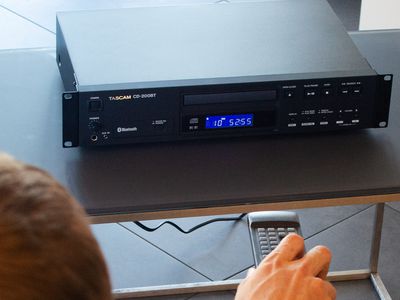
Lenovo Legion Go Examined: Ideal Screensize for On-the-Go Gaming Systems

Lenovo Legion Go Examined: Ideal Screensize for On-the-Go Gaming Systems
Key Takeaways
- Lenovo Legion Go offers high performance and a large, high-resolution screen for a PC gaming handheld.
- The Legion Go features a touchscreen display, removable controllers, and two USB-C ports.
- While the device has a good overall design and responsiveness, it has issues with battery life and optimization.
Lenovo makes some of the best laptops and desktops, competitive tablets and smartphones, and has a solid presence in gaming with its Legion brand. It’s only natural then that Lenovo would try and apply that depth and breadth of expertise to the burgeoning handheld PC gaming market.
Taking inspiration from Nintendo’s blockbuster Switch and some of the best PC gaming handheld designs, including Valve and Asus, Lenovo set out to make a statement with the Legion Go . While Lenovo has taken some of the best features of the competition and put together a compelling large-screen package, the Legion Go still has some growing pains that may keep it from being the top choice in PC gaming handhelds for many users.
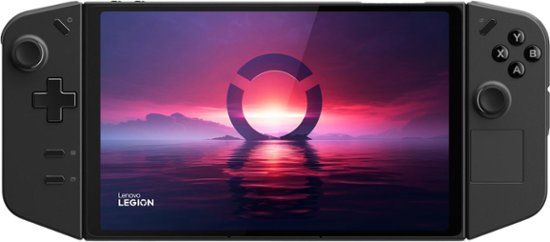
Lenovo Legion Go
7/ 10
Although not without its issues, the Lenovo Legion Go’s large display, removable controllers, and versatility make it a top choice among PC gaming handhelds.
Dimensions
Gamepad with controllers: 11.76 x 5.16 x 1.6 inches
Weight
Gamepad with controllers: 1.88 lbs
CPU
AMD Ryzen Z1 Extreme (8 cores, 16 threads, 3.3GHz)
GPU
AMD Radeon (RDNA™ 3 Architecture)
RAM
16GB LPDDR5x-7500 (soldered)
Storage
1TB M.2 2242 SSD
Display
8.8” WQXGA (2560×1600), Multi-touch, IPS, 500nits, 16:10, 144Hz, Corning Gorilla Glass 5
Speakers
Stereo speakers (2W x2) and dual-array microphone
Wireless Connectivity
802.11ax 2×2 Wi-Fi + Bluetooth® 5.1
Ports
1x microSD card reader, 1x Headphone/microphone combo jack (3.5mm), 2x Pogo pin connector (5-point), 2x USB4 40Gbps (support data transfer, Power Delivery 3.0, and DisplayPort™ 1.4)
Battery
49.2 Wh, supports Super Rapid Charge (10min charge 0~30% capacity, 30min charge 0~70% capacity, 80min charge 0~100% capacity)
Pros
- Large, impressive display
- Removable controllers
- Good heat management
- Versatile use cases
Cons
- Bulky
- Poor battery life
- Inconsistent software
Expand
$749.99 at Lenovo $749.99 at Best Buy
Specifications: A Powerhouse With Big Sights, OK Sounds
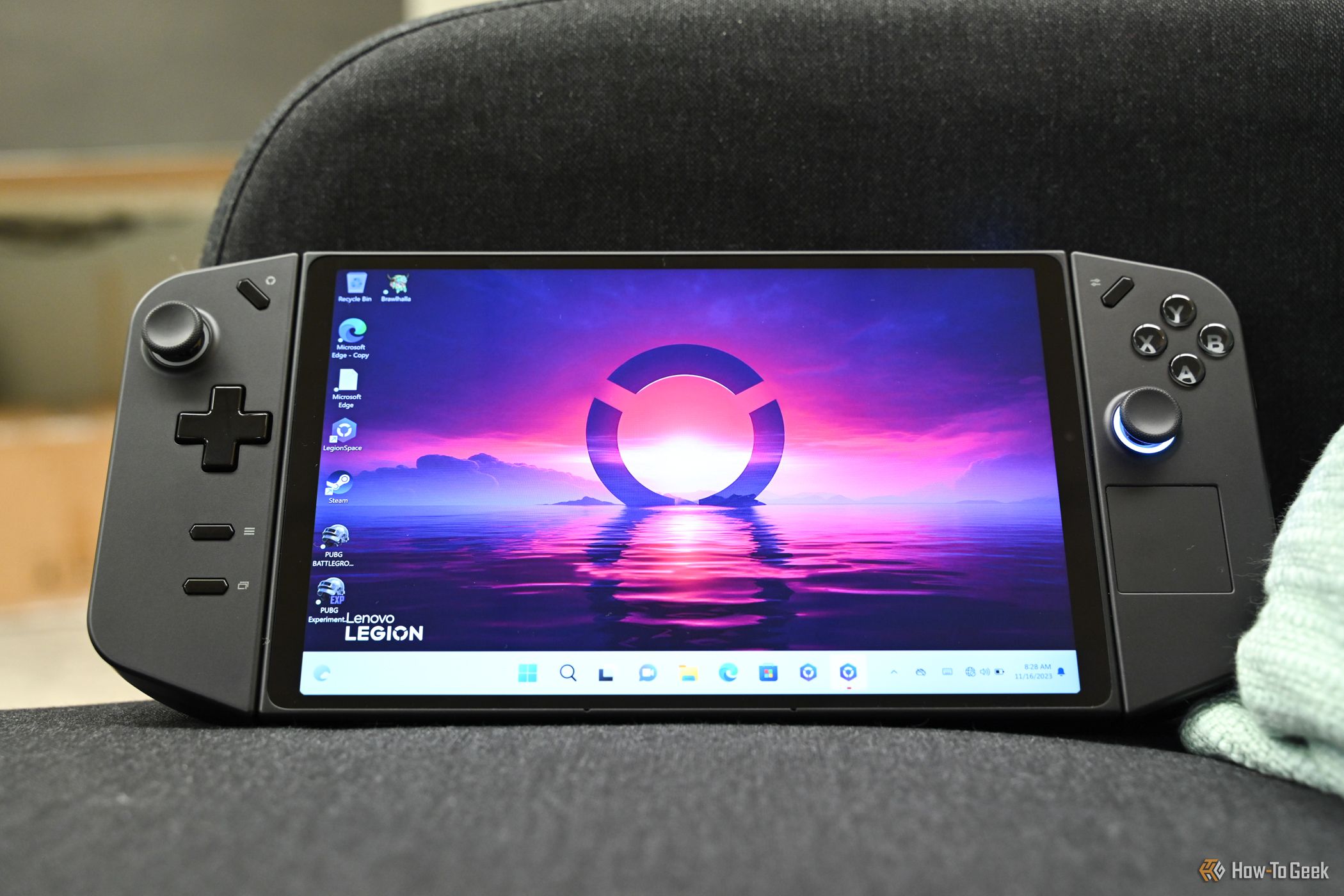
Hannah Stryker / How-To Geek
With its AMD Ryzen Z1 Extreme (8 cores, 16 threads, 3.3GHz) CPU, AMD Radeon (RDNA 3 Architecture) GPU, and 16GB of soldered LPDDR5x-7500 RAM, the Legion Go has enough performance to go toe-to-toe with just about any other PC gaming handheld to date. The $699.99 retail price for a Legion Go with 512GB storage is competitive with the similarly capable Asus ROG Ally Z1 Extreme . For just $50 more or roughly $100 more than the most expensive Valve Steam Deck OLED, you can get the Legion Go with 1TB of storage , a storage option not even available with the ROG Ally.
The Legion Go stands out in two areas from its mainstream competition: screen size and controls. Compared to the Steam Deck OLED’s 7.4-inch 1,280 x 800 90Hz display, or the ROG Ally’s 1,920 x 1,080 120Hz display, the Legion Go’s larger 8.8-inch PureSight LCD screen has a higher WQXGA resolution of 2,560 x 1,600, and higher refresh rate of 144Hz. In terms of controls, the Legion Go is the only mainstream option to mimic the Switch with removable controllers, allowing Lenovo’s handheld to turn into a tabletop gaming station or Windows tablet.
Although it doesn’t feature the rich blacks and high contrast of an OLED display, the Legion Go’s LCD has excellent color reproduction with 100% of sRGB and a brightness of 500 nits. Overall, the Legion Go’s display can compete with any other PC gaming handheld display out there, even OLED. Unfortunately, there are few opportunities to take advantage of the display’s native resolution and refresh rate when gaming, with most titles only performing their best at a resolution of 1,280 x 800 and a refresh rate of 60Hz.
As a touchscreen, the Legion Go’s display performs well, supporting typical one- and two-finger touch gestures for shortcuts, zooming in and out, and more. It’s a nice alternative to the included touchpad, which provides the basic functionality of an external mouse, save for its lack of physical mouse buttons, which are promised to be enabled in a future firmware update.
The built-in speakers are nice and loud and are free of distortion, but there’s not much stereo separation. They’re a step below the ROG Ally’s best-in-class surround sound effect, falling more in line with the Steam Deck’s speakers.
A particularly nice feature of the Legion Go is its two multi-purpose Type-C USB connectors, one on the top of the unit and one on the bottom, allowing for more options than other handhelds with just one such port. These full-featured ports can support power, display, and Thunderbolt 3-enabled docks or devices, including eGPU enclosures for those who want more graphical punch when docked.
Most PC gaming handhelds provide roughly 30 minutes to a few hours of gameplay on battery when playing more demanding games. The Legion Go is no exception due in part to the same type of 50Wh battery as the smaller Steam Deck OLED. Lenovo’s handheld simply lacks the same efficiencies that give Valve’s handheld its best-in-class battery life, which is at least double that of the Legion Go. Regardless, performance with PC gaming handhelds is always going to be best when plugged in as it allows for maximum power draw and for all parts to run at the top of their performance curves.
Design and Feel: Comprehensive, but Clunky
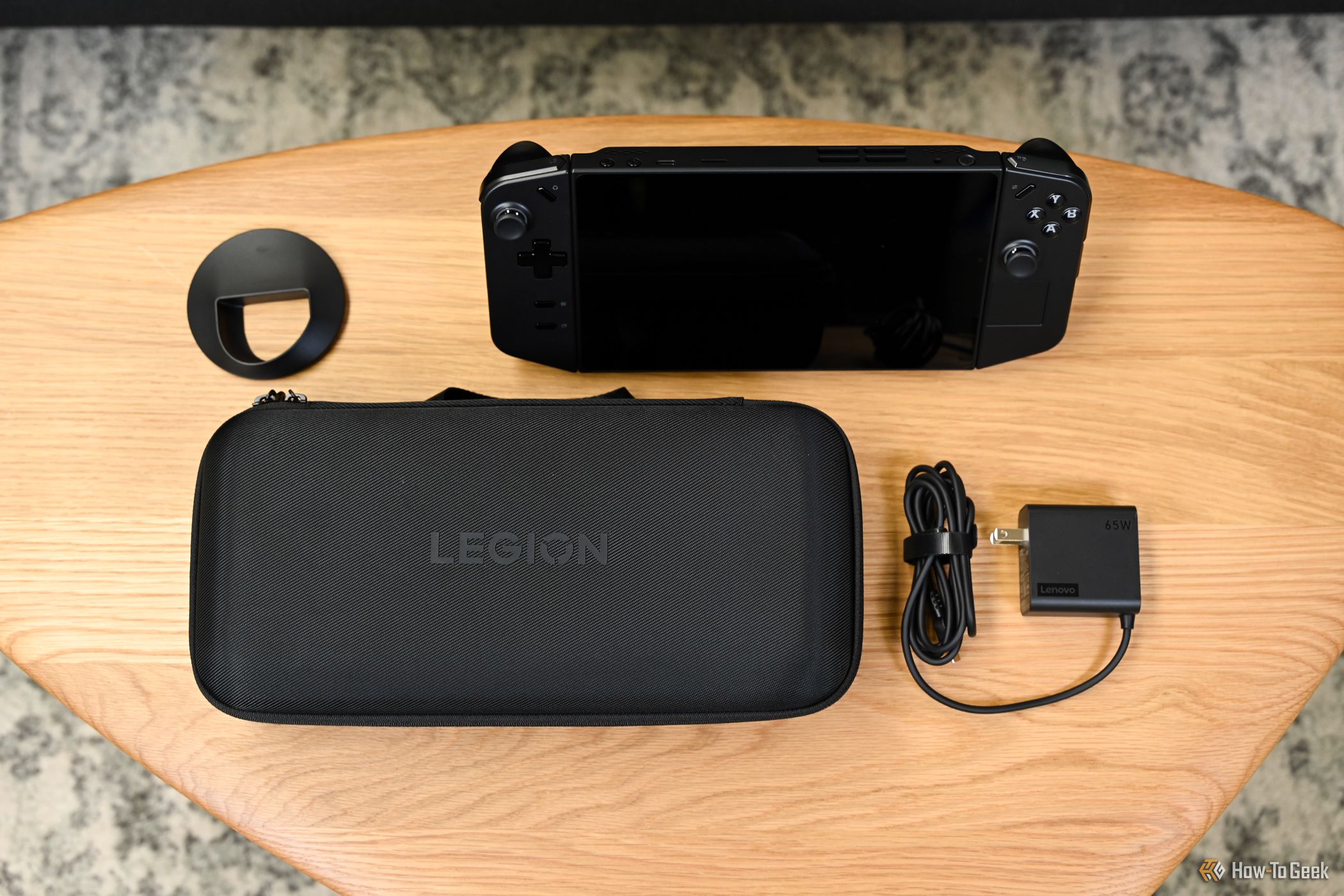
Hannah Stryker / How-To Geek
The designers at Lenovo seem to have taken at least some inspiration from the design of the AYAYNEO 2021 , with its similarly tapered angles and general layout. Of course, Lenovo is a much larger company and went next level on things like overall build quality and features, so the comparison is superficial at best.
Like just about every other PC gaming handheld, the Legion Go adopts the Xbox controller’s general functionality and ABYX button pattern used by most PC games. Button layout and other options can be reconfigured in settings, including the additional programmable rear buttons.
With the TrueStrike controllers attached to the tablet body, the Legion L, LB, left joystick/LS, D-pad, View, Menu, Legion R, RB/M1, ABXY, right joystick/RS, touchpad, and M2 controls are at the front of the console. On the rear of the controllers are programmable Y and M buttons, as well as a mouse wheel for scrolling content or zooming in and out. There’s also an ambient light sensor that detects and measures the intensity of environmental light for adaptive screen brightness, as well as microphones, but no cameras. At the top and rear of the unit are air vents, with the largest just above the kickstand.
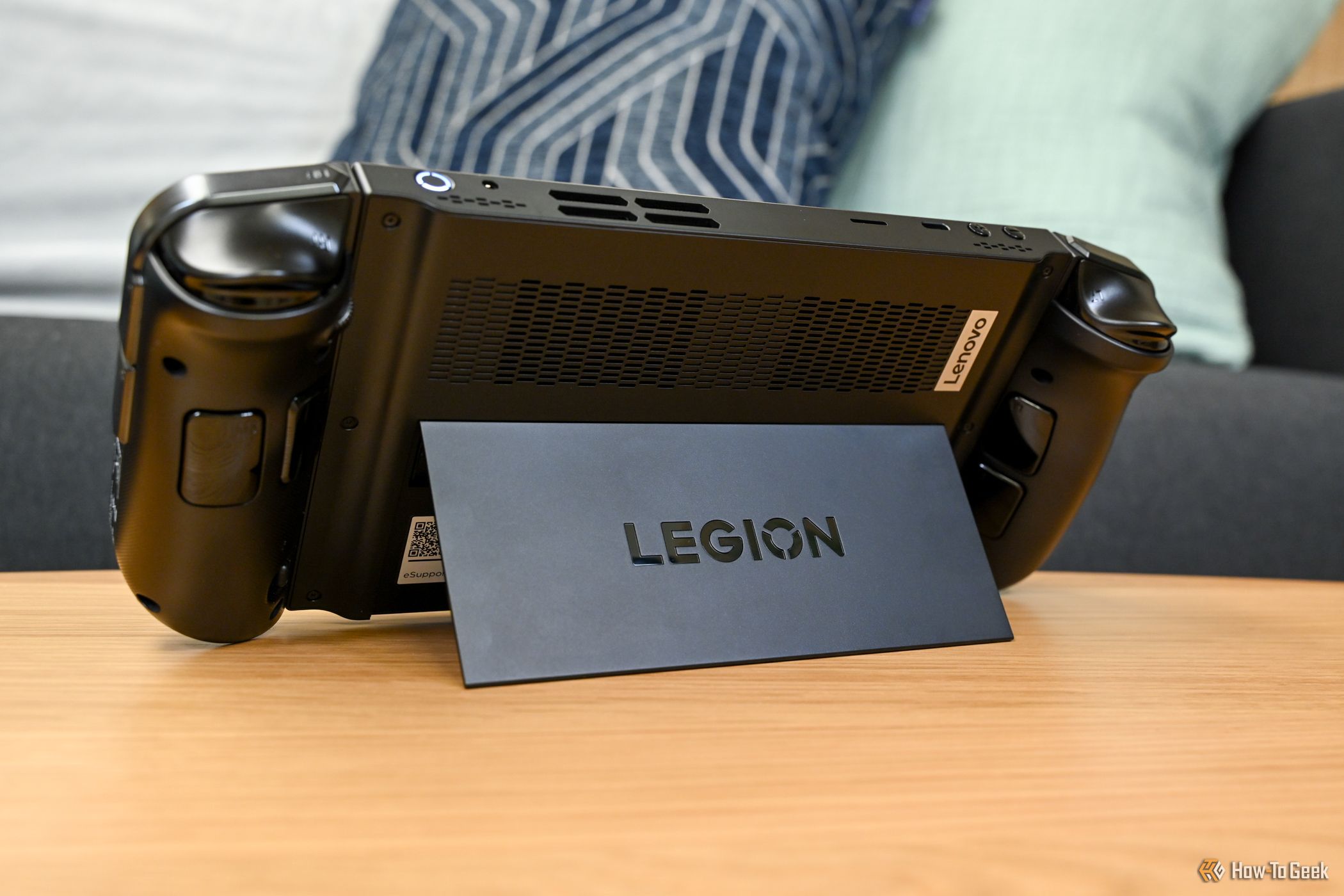
Hannah Stryker / How-To Geek
At the top of the tablet are volume buttons, speakers, a USB-C connector, a microSD card slot, a combination 3.5mm audio jack, and a power button with a power light. The power light indicates the tablet’s current power state when it’s not connected to the included AC power adapter, with white blinking slowly for sleep mode and a greater than 90% battery charge level, and amber blinking slowly for sleep mode and less than a 91% battery level.
The color of the power light can also indicate the tablet’s active thermal mode when powered on, with white for balance, blue for quiet, red for performance, and purple for custom. Similarly, there are customizable RGB ring lights around each of the analog sticks.
With the controllers attached, the Legion Go weighs around 1.88 pounds and has a width of roughly 11.76 inches. There’s no mistaking how bulky this handheld is in comparison to similar devices with smaller screens. With that said, the controllers have generous handles that make holding the device much easier and better balanced than it otherwise would be, and the built-in adjustable kickstand makes tabletop play a real option should your arms get tired.
I would have liked for the controllers to attach more securely to the tablet body. The release buttons make it relatively easy to remove and reattach the controllers as needed, but once they’re in place, the device feels noticeably less cohesive than most of the other PC gaming handhelds with built-in controls. Of course, the fact that the controllers are removable does open up additional possibilities not available on other devices of this type, including easy replacement should one of the controllers break or as-yet-to-be-realized third-party alternatives.
Detached controllers connect to the console via Bluetooth and can be switched between X-input or D-input modes for greater compatibility. There’s an FPS switch on the bottom of the right controller that is designed specifically for first-person shooter games. Once switched, the right controller can then be placed in the included small plastic circular dock and slid on a desktop similar to a vertical mouse, with additional controls available from the left-hand controller. It’s a unique way to play FPS games without the need for a separate mouse and keyboard, a bit like an in-between version of that control method and a gamepad. It won’t be a control scheme for everyone, but it may help to reduce clutter for those willing to give it a chance.
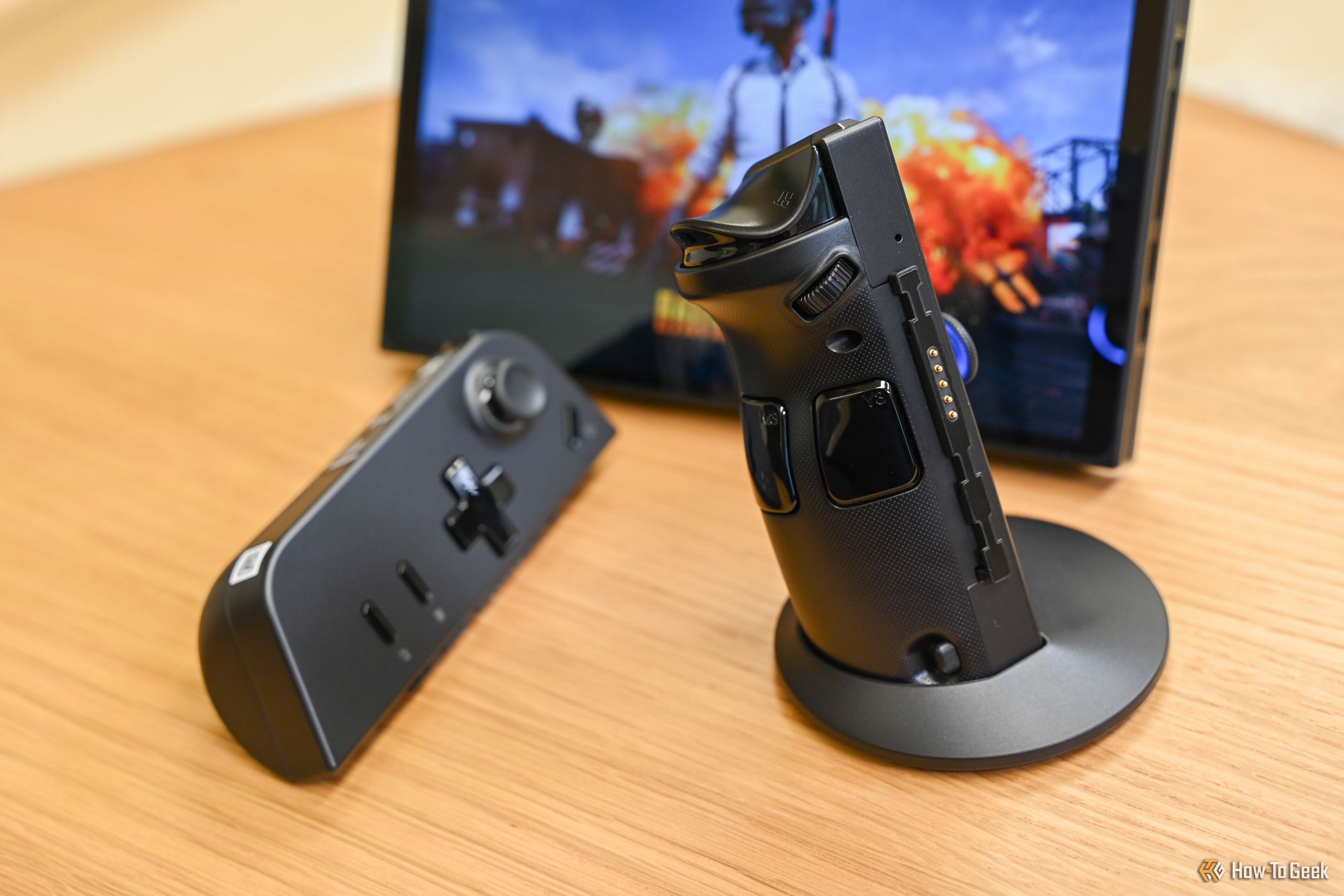
Hannah Stryker / How-To Geek
The included hard storage case is a nice touch and fits both the handheld and the right controller dock. Considering the battery life on PC gaming handhelds like this, it would have been nice to include space for the AC adapter as well, but the fact that a carrying case is included at all is a plus. Even better, there’s a small flap near the bottom left USB-C port where you can charge the Legion Go while it’s still in the case.
Shortly after the Legion Go’s release, there were reports of analog stick dead zones and poor response curves. Fortunately, it appears this was a software issue, rather than hardware one. With the latest firmware updates, I found the analog sticks to be responsive and also appreciated the addition of robust tuning controls. Overall responsiveness of all controls and buttons was excellent, though there were two notable exceptions. One is the trackpad, which should be resolved in a future firmware update, and the other, the D-pad, which is a design issue.
Playing a game like “Words Can Kill” shows the limitation of the trackpad and its lack of dedicated mouse buttons before the promise of a future firmware update. Instead, you need to tap on the touchpad to activate the mouse button, which really doesn’t work well for use cases like this. Instead, the touchscreen proves the better option for dragging and dropping letters in the game.
“Pac-Man Museum+,” with its selection of maze games, is one of my favorite ways to test the precision and responsiveness of D-pads. Unfortunately, the Legion Go’s D-pad, while a step up from the ROG Ally’s, was no match for the Steam Deck’s, and a disappointment for most games outside of menu navigation.
In theory, you can detach the controllers and use the main tablet body in portrait mode for portrait mode games, but I found this to be a clumsy process. Legion Space , which is Lenovo’s app for managing game resources, controlling hardware settings, and checking the operational status of the device, would always switch the device back to landscape mode. I had to launch the game directly from the Windows 11 interface or the respective digital store launcher for the Legion Go to keep the portrait orientation I wanted.
Software and Configuration: Pay Attention to Windows
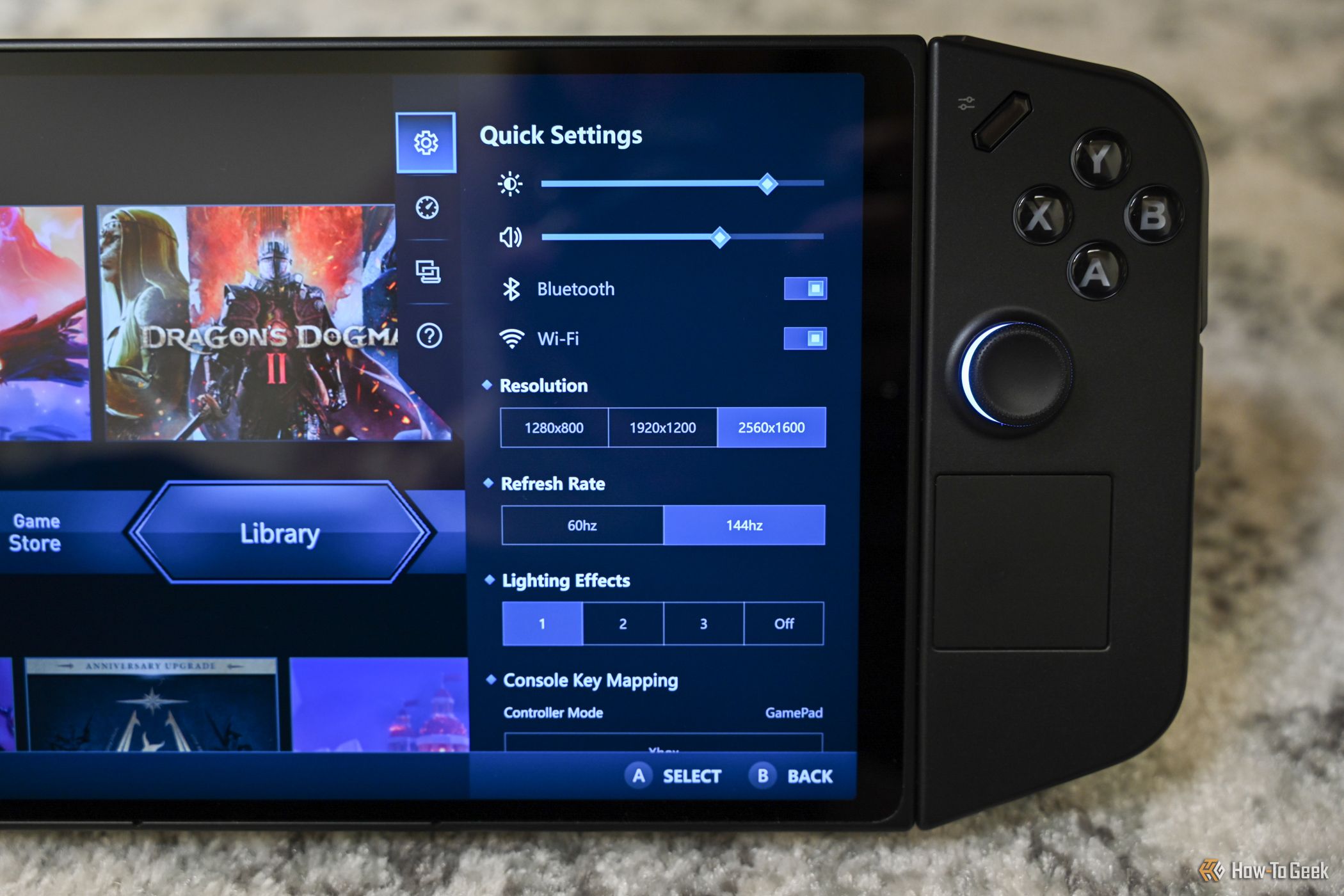
Hannah Stryker / How-To Geek
Like most PC gaming handhelds not named Steam Deck, the Legion Go runs Windows 11, which is incredibly versatile, but has the downside of greater complexity. While you can do a lot from Legion Space, which can always be accessed from the Legion L button above the left analog stick, the reality is you’ll be switching back and forth between Windows regularly.
Through Legion Space, you can install the Xbox, Epic, Ubisoft, Steam, GOG, and Rockstar game stores, as well as purchase digital games for many of these services directly through Lenovo. There’s even an option to play emulated Android games through the Amazon Appstore. Otherwise, anything else you may want to do or install can be or is done directly in Windows, including adding Bluetooth devices.
After installing a game through most game stores, it appears under the Library category in Legion Space, at least in theory. If for some reason it doesn’t, there’s an option to manually add a game or app. Even with the library shortcut, the Legion Go may still drop out to Windows to load additional content, or otherwise have Windows pop-ups surface.
In addition, not every game in the Legion Space Library showed me the correct icon. For instance, while everything from the Steam store I installed had the correct icon, a few games from the Epic and Xbox stores didn’t, like “Deathloop,” “DNF Duel,” “High on Life,” and others. Overall, Legion Space is not as refined as the ROG Ally’s Armoury Crate SE or the Steam Deck interface, although, like those two front ends, updates continue to be released.
Using the Legion R button above the ABXY buttons opens the Legion Space settings, where you can quickly access features like performance modes, controller options, lighting effects, display brightness, volume, Bluetooth and Wi-Fi on or off, resolution, refresh rate, frame rate monitoring display options, and Radeon Super Resolution (RSR), which is an upscaling feature that allows games that are natively in a lower resolution to be upscaled to a higher resolution. This feature is particularly useful on the Legion Go, where playing games smoothly in 1,280 x 800 is far more likely than 1,920 x 1,200 or the display’s native 2,560 x 1,600.
Thanks to the built-in kickstand, if you have a monitor like the INNOCN Ultrawide 40-Inch 40C1R , you can do power and video over the Legion Go’s top-mounted USB-C connection, then just use your choice of Bluetooth mouse and keyboard for a compact dual-screen desktop computing experience. Of course, since the Legion Go has USB-C ports on both the top and bottom, just about any proper USB-C-based dock will also work should you want access to a third monitor, hardwired networking, or just more ports. While a PC gaming handheld should never be a first choice for a compact general-purpose PC, as a secondary function, the Legion Go is easily one of the most versatile options in the category.
In just a few months since its launch, the Legion Go has already improved dramatically thanks to various software updates, including to Legion Space. More are planned , including additional performance tuning options, as well as that much-needed ability to use the left and right triggers for mouse clicks to take full advantage of the trackpad.
Games and Gameplay: Potential Powerhouse
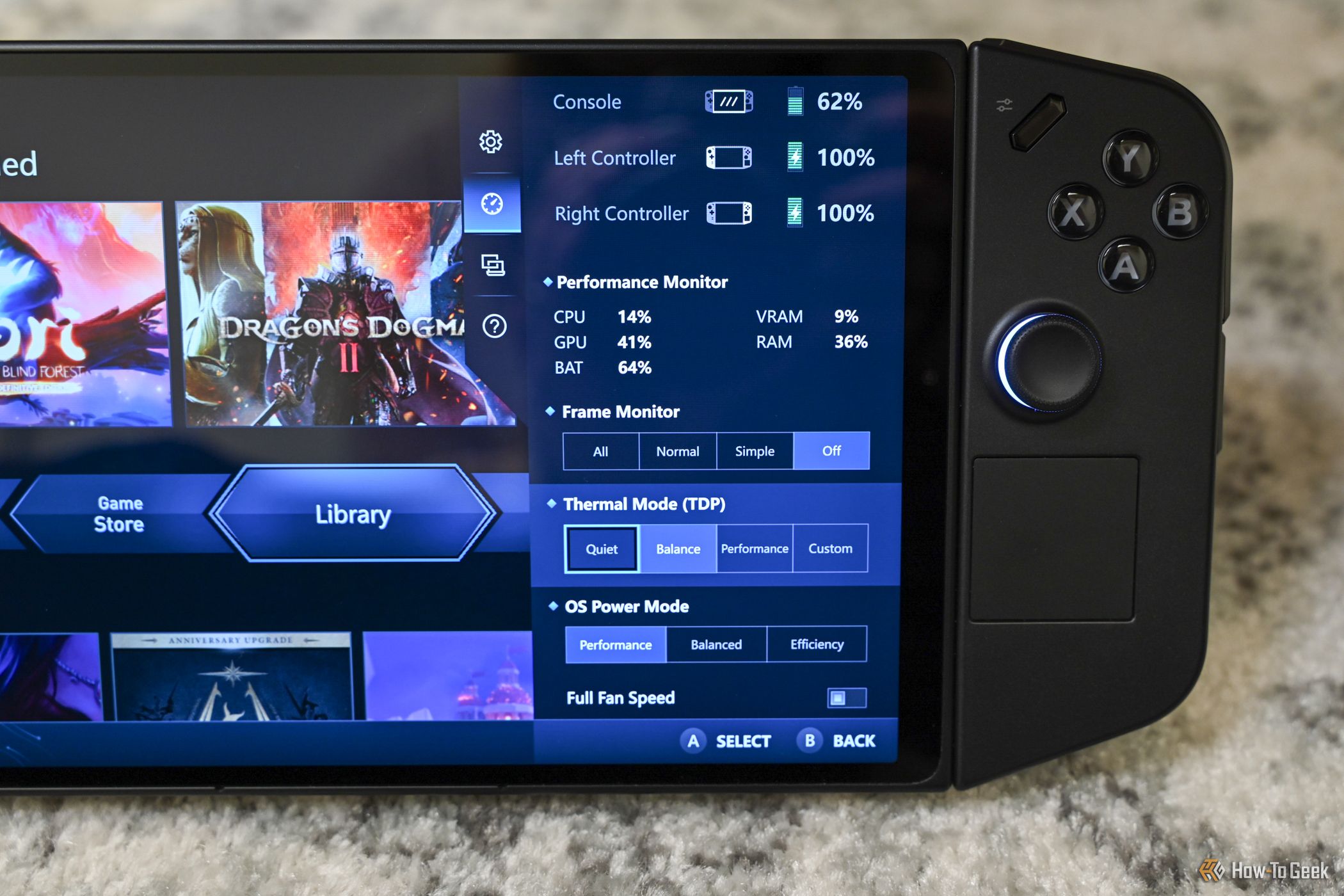
Hannah Stryker / How-To Geek
Ultimately, the games and gameplay are what matters for a device like this. In that regard, the Legion Go’s performance doesn’t disappoint, although there are some notable caveats. For instance, if you expect to take regular advantage of the native 2,560 x 1600 resolution on anything but the most basic games, forget about it. Like every other PC gaming handheld, most games will play smoothest on the lowest practical resolution, which in this case is 1,280 x 800. Even the refresh rate of 144Hz is often wasted, making 60Hz a much more practical option.
As a relatively modest game, the popular “Dave the Diver” is a good example of what to expect in terms of performance and battery life. With brightness set to 42%, volume on my AirPods Pro set to 50% over Bluetooth, power-saving mode active, TDP set to balanced, OS power mode set to performance, resolution set to 1,920 x 1,200 for both the game and Legion Go itself, and 144Hz refresh rate, I was able to get a steady 59 - 60FPS. After 45 minutes of play, however, only 53% of the battery was left.
On the other hand, unlike some other PC gaming handhelds with smaller screens, like the ROG Ally or Steam Deck, the smaller text and undersea objects present in “Dave the Diver” were much easier to see on the Legion Go’s larger display. Although PC games are getting better optimized for these types of portable displays, small text and objects are going to be an issue for quite some time, so Lenovo’s decision to feature a larger display at the expense of some portability is a good one in that regard.
A more demanding game like “Diablo IV” required considerably more tweaks. To get the game to work at all on the Legion Go, I had to go into Steam and delete dstorage.dll from the local files, again highlighting how gaming on a PC, particularly one centered around Windows, is not always user-friendly. Further, with the resolution set to 1,920 x 1,200, I got frame rates mostly in the 30s, with dips into the 20s for the more intense areas. Only with Medium in-game visual settings and the resolution set to 1,280 x 800 did I consistently go over 50FPS, and in some less intense areas, well over 60FPS.
Even a game that you would think would have modest requirements, like “Pinball FX,” can really only sustain a solid 60FPS when the in-game resolution is set to 1,920 x 1,200 at medium graphics quality in borderless window mode. In short, never expect something truly plug-and-play on a PC gaming handheld like you can on a Nintendo Switch. Experimentation is critical to getting the best possible experience out of one of these devices.
Like any PC gaming handheld, the Legion Go does get warm and vents hot air after any appreciable play time, but it remains relatively quiet in comparison to other such devices even after intensive gaming sessions. There’s no denying that the Legion Go is easily among the quietest and best thermally regulated PC gaming handhelds on the market.
Should You Buy the Lenovo Legion Go?
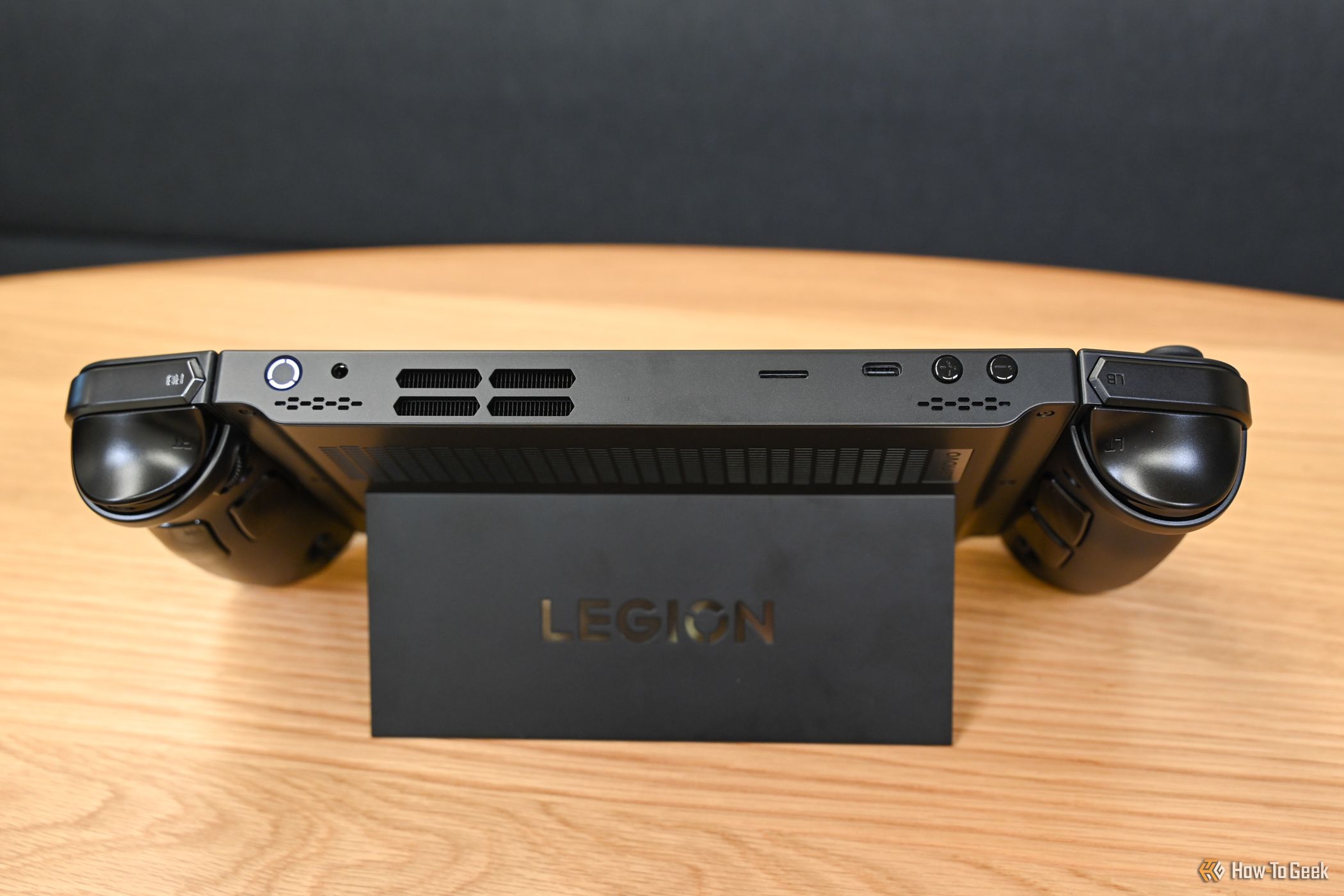
Hannah Stryker / How-To Geek
The PC gaming handheld market is really crowded right now, but the Legion Go does just enough to be one of the stand-outs. Despite having some defining features, like its large screen and removable controllers, it also has enough deficiencies, like some bulkiness and lack of polished software, where they’re not necessarily enough of an advantage to make this an easy first choice in the category.
Ultimately, I still recommend the greater polish of the ROG Ally for those who don’t need the relative simplicity of the Steam Deck, but if the Legion Go’s larger screen, removable controllers, and better usability as a general PC appeal to you, it’s a solid choice. As with the other major maker PC gaming handhelds, the Legion Go will likely also continue to improve over time thanks to regular updates that have already made this a better device than when first released.

Lenovo Legion Go
7/ 10
Although not without its issues, the Lenovo Legion Go’s large display, removable controllers, and versatility make it a top choice among PC gaming handhelds.
- Title: Lenovo Legion Go Examined: Ideal Screensize for On-the-Go Gaming Systems
- Author: Jeffrey
- Created at : 2024-08-30 09:01:12
- Updated at : 2024-08-31 09:01:12
- Link: https://some-knowledge.techidaily.com/lenovo-legion-go-examined-ideal-screensize-for-on-the-go-gaming-systems/
- License: This work is licensed under CC BY-NC-SA 4.0.


 Easy GIF Animator is a powerful animated GIF editor and the top tool for creating animated pictures, banners, buttons and GIF videos. You get extensive animation editing features, animation effects, unmatched image quality and optimization for the web. No other GIF animation software matches our features and ease of use, that’s why Easy GIF Animator is so popular.
Easy GIF Animator is a powerful animated GIF editor and the top tool for creating animated pictures, banners, buttons and GIF videos. You get extensive animation editing features, animation effects, unmatched image quality and optimization for the web. No other GIF animation software matches our features and ease of use, that’s why Easy GIF Animator is so popular.